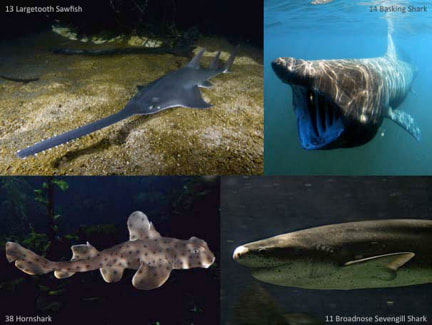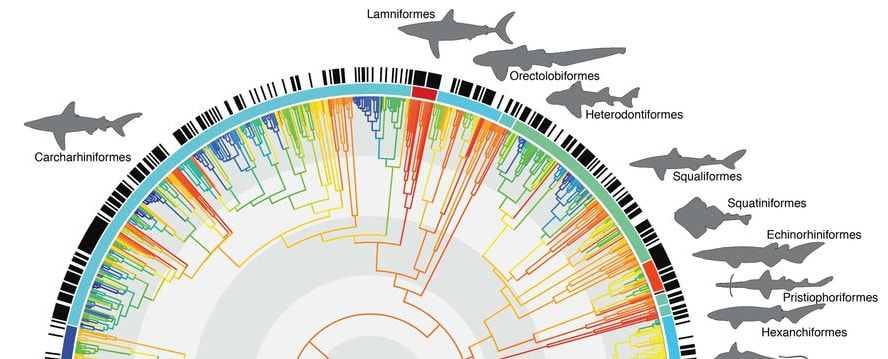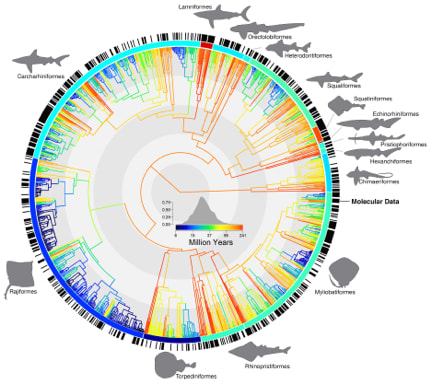Saving sharks with trees: researchers aim to save key branches of shark and ray tree of life18/1/2018
New study identifies conservation priorities based on evolutionary history and biogeography PRESS RELEASE | January 18, 2018 “While we’ve all heard of white sharks and manta rays, how many of us have heard of the Colclough’s shark or the sharkray?” asks Christopher Mull, an SFU postdoctoral fellow and one of the study’s lead authors. “Most shark and ray species are underappreciated because they aren’t featured in the popular media, but they often play important biological, sociological, or economic roles and deserve conservation attention.”  Biological diversity in the Top 20 imperiled species. Sawfish are characterized by their long rostra with teeth that they use to stun prey; Basking sharks are filter feeders; Broadnose sevengill sharks are members of a small lineage of temperate cold-water species; and Hornsharks are small coastal species that feed on hard bodied prey and lay eggs in the crevices of shallow reefs. Images: D. Wackenfelt, G. Skomal, JNP Nuñez, DR Roberson. By quantifying how much unique evolutionary history a species accounts for (also known as their evolutionary distinctness), the researchers discovered that the extinction of a single shark or ray species would prune an average of 26 million years of distinct evolutionary history from the shark and ray tree of life. That’s twice the amount for an average mammal and more than four times that for an average bird. “We were excited to see that the most evolutionarily distinct shark and ray species included a diversity of forms and functions,” says SFU biological sciences professor Nick Dulvy, a senior author of the study. “Everything from deep-water and filter-feeding sharks to electric rays and sawfish rose to the top as being particularly evolutionarily distinct.” Taking this a step further to better focus efforts in marine conservation, the authors combined evolutionary distinctness with range maps to understand how shark and ray evolutionary history is distributed throughout the oceans. The researchers identified five priority hotspots for shark and ray conservation:
With this information, the Zoological Society of London will soon launch an EDGE (evolutionary distinct & globally endangered) sharks conservation initiative under the EDGE of Existence programme. It will help build local expertise and capacity for the conservation of threatened evolutionarily distinct sharks and rays. “Our main concern was to produce a tool that conservation practitioners will actually use," says SFU biodiversity professor Arne Mooers, and a senior author. "The goal is to help conserve as much of the Tree of Life as possible." Fast Facts
Learn more
MediaPHOTOS: https://vault.sfu.ca/index.php/s/WmjmIRz1XR34HAq STUDY: https://www.nature.com/articles/s41559-017-0448-4 PRESS RELEASE: https://www.sfu.ca/university-communications/issues-experts/2018/01/saving-sharks-with-trees.html CONTACT: Christopher Mull, Biological Sciences, 778.389.6439, [email protected] Nicholas Dulvy, Biological Sciences, 778.782.4124, [email protected] Arne Mooers, Biological Sciences, 604.358.2313, [email protected] Wan Yee Lok, Communications & Marketing, 778,782.3210, [email protected] ReferenceStein, R.W., Mull, C.G., Kuhn, T.S. et al. Global priorities for conserving the evolutionary history of sharks, rays and chimaeras. Nat Ecol Evol 2, 288–298 (2018). https://doi.org/10.1038/s41559-017-0448-4
Comments are closed.
|



 RSS Feed
RSS Feed